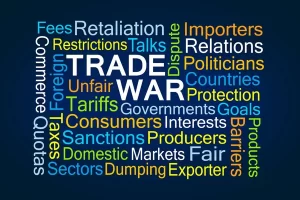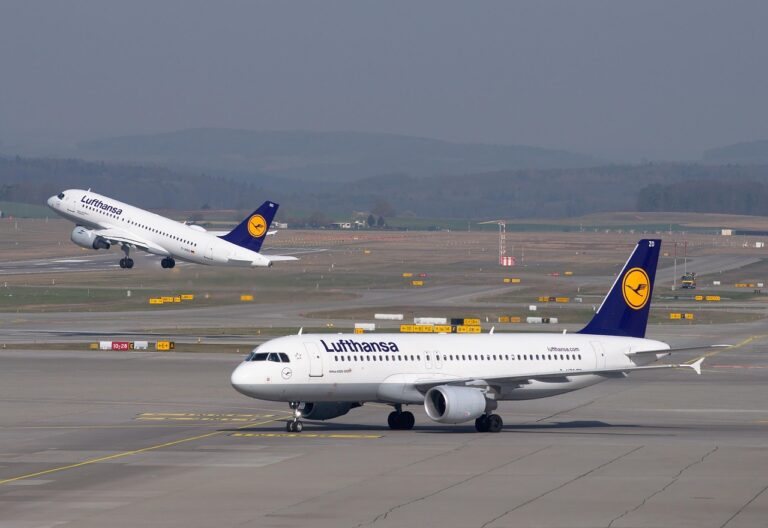How Tariffs Are Changing the World: Winners, Losers, and What Comes Next?
tariff war, trade war, inflation, supply chains, job losses, consumer impact, China, visa-free policy, global trade, 2025 trends
The Tariff War Era
How Tariffs Are Changing the World, which is in the middle of a new tariff war, and its effects are everywhere. From farmers in Iowa to tech giants in Shenzhen, businesses and families are feeling the heat. This article explores how the tariff war is reshaping industries, consumer prices, jobs, and even travel. We’ll also look at how China’s visa-free entry policy is changing the game for its businesses and what challenges come with it.https://mrpo.pk/tariff-war/

Why is Trump using tariffs?
Trump has strongly defended his tariff policy, but influential voices within his Republican Party have joined opposition Democrats and foreign leaders in attacking the measures.
Announcing its latest forecasts, the IMF has said Trump’s tariffs mean that it now expects the global economy to grow by 2.8% in 2025, which is down from its previous estimate of 3.3%. US growth is now predicted to be 1.8% for the year, down from the 2.7% that had been anticipated in January.
Tariff War and Inflation: The Hidden Tax on Households
Tariff wars act like invisible taxes. When countries like the U.S. and China slap tariffs on each other’s goods, companies pay more to bring in products. They pass these costs to consumers, making everyday items like washing machines, clothes, and electronics more expensive. For example, after the U.S. imposed tariffs on Chinese goods, washing machines jumped 12% in price. Inflation rises, and families find their budgets stretched thinner than ever.
Trade War Effects on Consumers: Less Choice, Higher Costs
Consumers are among the biggest losers in a tariff war. With tariffs in place, imported goods become pricier, and sometimes even hard to find. Domestic companies, facing less competition, may also raise their prices. Imagine going to the store and seeing your favourite brand of sneakers or electronics suddenly cost much more-or not being available at all. That’s the reality for many shoppers during a trade war.
Tariff War and Job Losses: Winners, Losers, and Broken Promises
Tariffs are supposed to protect jobs, but the reality is more complicated. While some domestic factories may get a boost, many other sectors suffer. U.S. farmers, for example, lost a huge chunk of their export market when China imposed retaliatory tariffs. Manufacturing hubs in North America and Europe have also seen layoffs as costs rise and export orders fall. Even port workers and truck drivers feel the pinch as trade volumes drop.
How Tariffs Are Changing the World: Supply Chain Chaos from Factories to Shelves
Global supply chains depend on smooth, predictable trade. Tariffs throw a wrench in the works. Factories in China, the U.S., and Europe face sudden changes in demand. Some run at half-capacity, while others scramble to find new suppliers or buyers. Companies are moving production to countries like Vietnam or Mexico, but this shift takes time and money. The result? Delays, shortages, and higher prices for everything from smartphones to cars.
Future of Trade Tariffs: Escalation or Resolution?
What’s next for the tariff war? Some experts warn that if tariffs stay in place, economies could shrink and job losses could mount. Others say businesses will adapt, shifting supply chains and finding new markets. The best outcome would be a diplomatic solution, but political tensions remain high. For now, companies and consumers must brace for a bumpy ride.
Most Affected Industries: Who’s Feeling the Pain?
Some industries are hit harder than others:
-
Agriculture: U.S. farmers lost major export markets, especially for soybeans and pork, as China turned to Brazil and other suppliers.
-
Technology: Tech firms like Apple and Nvidia face higher costs and supply chain headaches.
-
Apparel and Footwear: Brands like Nike and Gap rely on Asian factories, now subject to high tariffs.
-
Automotive: U.S. and European carmakers face steep export barriers and rising parts costs.
-
Energy: U.S. oil and gas exporters lose out as China cuts purchases.
-
Pharmaceuticals: Drugmakers pay more for key ingredients sourced from China.
Job Losses: Which Sectors Are Suffering Most?
-
Agriculture: Farmers, especially those exporting to China, face layoffs and bankruptcies.
-
Manufacturing: Auto, machinery, and electronics workers are losing jobs as costs rise and exports fall.
-
Logistics and Transportation: Port workers, truck drivers, and freight handlers see reduced hours or layoffs.
-
Apparel and Footwear: Factory jobs in Asia and export-dependent roles in the U.S. are at risk.
-
Pharmaceuticals and Electronics: Layoffs occur as companies cut costs due to pricier imports.

How Tariffs Are Changing the World
Domestic Market Benefits: Who’s Winning at Home?
It’s not all bad news. Some domestic industries benefit from tariffs:
-
Local Manufacturers: With foreign goods more expensive, local producers gain market share.
-
Government Revenue: Tariffs bring in billions in tax revenue that can be used for public projects.
-
Self-Sufficiency: Countries like the U.S. and China are investing in local production of essentials like semiconductors and medicines.
-
Domestic Tourism and Retail: Policies like China’s visa-free entry boost spending at home.
Gainers and Losers: Countries and Businesses in the Tariff War
Gainers:
-
Brazil: Wins big in agriculture, especially soybeans, as China seeks new suppliers.
-
Vietnam and Southeast Asia: Attract manufacturing shifting away from China.
-
Tech Giants (Nvidia, TSMC): Benefit from exemptions and continued demand.
Losers:
-
China faces high tariffs, lost export markets, and supply chain disruption.
-
U.S. Farmers: Lose access to China, their biggest customer.
-
European Luxury and Auto Brands: Hit by tariffs in both the U.S. and China.
-
Chinese Exporters: Electronics and apparel face steep U.S. tariffs.
How Tariffs Are Changing the World: China’s Retaliation, How Beijing Fights Back
China isn’t sitting back. Its countermeasures include:
-
Escalating Tariffs: Up to 140% on U.S. goods, especially agriculture and luxury.
-
Export Controls: Restricting critical minerals like rare earths, hurting tech and defence sectors.
-
Blacklisting: Adding U.S. companies to “unreliable entity” lists, limiting their business in China.
-
Regulatory Pressure: Launching investigations and anti-dumping probes against U.S. firms.
-
Import Bans: Blocking U.S. agricultural products from certain exporters.
-
WTO Complaints: Filing legal challenges to U.S. tariffs.
-
Diplomatic Warnings: Threatening countermeasures against U.S. allies.
China’s Visa-Free Entry Policy: A New Boost for Business
China’s new visa-free entry rules are a bright spot for domestic businesses:
-
Tourism Surge: Foreign arrivals more than doubled, with 20 million visitors in 2024.
-
Retail Boom: Luxury malls and shopping districts in cities like Shanghai and Hainan report record sales.
-
Cruise Tourism: New policies attract more cruise passengers, boosting local economies.
-
Business Travel: Easier entry for professionals encourages spending on hotels, dining, and tech.
Challenges of Visa-Free Entry for Businesses
But there are hurdles:
-
Infrastructure Strain: Sudden tourist surges can overwhelm hotels and transport.
-
Security Risks: Visa-free stays can lead to illegal work or overstays.
-
Compliance Issues: Not all travellers understand the limits of visa-free entry, risking fines for businesses.
-
Economic Imbalance: Some tourists spend little, straining local services.
-
Policy Reversals: Governments may suddenly change rules, disrupting business plans.
-
Competition: Local vendors face pressure from global chains in popular shopping zones.
The Tariff War’s Lasting Impact
The 2025 tariff war is more than a political standoff’s a force reshaping global markets, jobs, and daily life. Some industries and countries adapt and thrive, while others struggle with lost markets and higher costs. China’s visa-free entry policy shows how countries are finding new ways to boost their economies amid trade tensions. For businesses and consumers everywhere, the only certainty is change.
Citations:
- https://backlinko.com/seo-strategy
- https://searchengineland.com/seo-priorities-2025-453418
- https://www.wordstream.com/blog/seo-trends-2025
- https://www.beeza.id/2025/03/seo-optimization-in-2025-latest-techniques-you-need-to-know/?lang=en
- https://www.highervisibility.com/seo/learn/seo-strategies/
- https://medium.com/@applabx/seo-2025-the-ultimate-guide-to-dominate-search-bb1024def973
- https://lawwwing.com/en/seo-in-2025-trends-and-strategies-you-cant-ignore/
- https://www.linkedin.com/pulse/ultimate-guide-seo-2025-trends-tools-techniques-avinash-prashar-b6icc
- https://www.310creative.com/blog/seo-techniques-to-grow-organic-traffic

